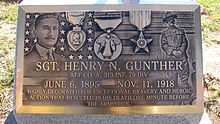Henry Gunther
| Henry Nicholas Gunther | |
|---|---|
| Born |
June 6, 1895 Baltimore, United States |
| Died |
November 11, 1918 (aged 23) Chaumont-devant-Damvillers, Meuse, France |
| Buried at | Most Holy Redeemer Cemetery, Baltimore |
| Allegiance | United States |
| Service/branch | United States Army |
| Years of service | 1917-1918 |
| Rank |
Sergeant (up to July 1918 or later) Demoted to private Posthumously restored to sergeant |
| Unit | 313th Infantry Regiment, 79th Division |
| Battles/wars |
World War I Battle of Saint-Mihiel |
Henry Nicholas John Gunther (June 6, 1895 – November 11, 1918) was an American soldier and the last soldier killed during World War I.[1][2][3] He was killed one minute before the armistice at 11 am.[2][4][5]
Early life
Henry Gunther was born into a German-American family in Baltimore, Maryland, on June 6, 1895.[2][3][5] His parents, George Gunther and Lina Roth, were both children of German immigrants.[2][6] He grew up in Highlandtown, an East Baltimore neighborhood heavily influenced by German immigrants,[3][7] where his family belonged to Sacred Heart of Jesus Roman Catholic parish.[6] Henry Gunther worked as a bookkeeper at the National Bank of Baltimore.[2][7] He joined the Knights of Columbus in 1915.[6][8]
War service
Gunther was drafted in September 1917 and was appointed to the 313th Regiment, which had the nickname "Baltimore's Own" and was part of the 157th Brigade of the 79th Infantry Division. As a supply sergeant, he was responsible for clothing in his military unit, and arrived in France in July 1918 as part of the American Expeditionary Forces. A critical letter home, in which he reported on the "miserable conditions" at the front and advised a friend to try anything to avoid being drafted, was intercepted by the censor. As a result, he was demoted from sergeant to private.[3][5][7]
Gunther's unit, Company A, arrived at the front on September 12, 1918. Like all Allied units on the front of the Meuse-Argonne Offensive, it was still embroiled in fighting on the morning of November 11.[9] The Armistice with Germany was signed by 5:00 am, but it would only come into force at 11:00 am. Gunther's squad approached a roadblock of two German machine guns in the village of Chaumont-devant-Damvillers. Gunther got up, against the orders of his sergeant and close friend, Ernest Powell, and charged with his bayonet. The German soldiers, aware of the armistice that would take effect in one minute, tried to wave Gunther off. He kept going and fired "a shot or two".[3] When he got too close to the machine guns, he was shot and killed instantly.[5][10] The writer James M. Cain, then a reporter for the Baltimore Sun, interviewed Gunther's comrades afterward and wrote that "Gunther brooded a great deal over his reduction in rank, and became obsessed with a determination to make good before his officers and fellow soldiers."[3]
General John J. Pershing's order of the day on the following day mentioned Gunther as the last American killed in the war.[10] The Army posthumously restored his rank of sergeant and awarded him a Divisional Citation for Gallantry in Action and the Distinguished Service Cross. A Veterans of Foreign Wars post in Baltimore was named after him.[2][3][11]
Gunther's remains were returned to the United States in 1923 and buried at Most Holy Redeemer Cemetery in Baltimore.[2][5] Subsequent investigations revealed that on the last day of World War I, between the signing of the armistice and its entry into force, about 11,000 men were wounded or killed - far more than usual.[12]
Memorials

On November 11, 2008, a memorial was constructed near the place where Gunther died.[citation needed] On November 11, 2010, a memorial plaque was unveiled at his grave site.[6]
Book and film
Roger Faindt wrote a book about Gunther, 10h59 ; Henry Gunther, le dernier soldat americain mort en 1918 (ISBN 2953512306, 2009). It is being adapted into an English language film titled 10h59, scheduled to begin shooting in 2013 with a budget of 12 million euros.[13]
See also
- George Edwin Ellison, the last British soldier killed
- George Lawrence Price, the last Canadian and British Empire soldier killed
- Augustin Trebuchon, the last French soldier killed
- John Parr, the first British soldier killed
- Jules Andre Peugeot, the first French soldier killed
References
| Wikimedia Commons has media related to Henry Nicholas Gunther. |
- ↑ Hayes-Fisher, John (October 29, 2008). "The last soldiers to die in World War I". BBC News. Retrieved October 24, 2012.
- ↑ 2.0 2.1 2.2 2.3 2.4 2.5 2.6 Meyer, Eugene (November 1, 2008). "The Unknown Soldier". Maryland Life. Retrieved October 25, 2012.
- ↑ 3.0 3.1 3.2 3.3 3.4 3.5 3.6 Rodricks, Dan (November 11, 2008). "The sad, senseless end of Henry Gunther". Baltimore Sun. Retrieved October 24, 2012.
- ↑ Persico, Joseph E. (2004). Eleventh Month, Eleventh Day, Eleventh Hour: Armistice Day, 1918: World War I and Its Violent Climax. New York: Random House. p. 351. ISBN 0-375-50825-2.
- ↑ 5.0 5.1 5.2 5.3 5.4 Edwards, Robert (October 15, 2006). "Henry Nicholas Gunther (1895 - 1918)". Find A Grave. Retrieved October 25, 2012. This page incorrectly lists Gunther's birth date as June 5, 1895.
- ↑ 6.0 6.1 6.2 6.3 "Dedication of the Memorial to Brother Knight Henry N. Gunther" (PDF). Maryland State Council of the Knights of Columbus. 2011. Retrieved October 25, 2012.
- ↑ 7.0 7.1 7.2 Persico, p. 134.
- ↑ Bauernschub, John P. (2008). The Knights of Columbus: Fifty Years of Columbianism in Maryland. Wildside Press. p. 209. ISBN 9781434474278.
- ↑ Persico, pp. 134-135.
- ↑ 10.0 10.1 Persico, p. 351.
- ↑ Persico, p. 394.
- ↑ Persico, p. 378.
- ↑ "10h59". Montreal World Film Festival. p. 2. Retrieved April 18, 2012.